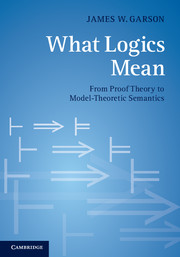Book contents
- Frontmatter
- Dedication
- Contents
- Preface
- Acknowledgements
- 1 Introduction to model-theoretic inferentialism
- 2 Deductive expression
- 3 Local expression
- 4 Global expression
- 5 Intuitionistic semantics
- 6 Conditionals
- 7 Disjunction
- 8 Negation
- 9 Supervaluations and natural semantics
- 10 Natural semantics for an open future
- 11 The expressive power of sequent calculi
- 12 Soundness and completeness for natural semantics
- 13 Connections with proof-theoretic semantics
- 14 Quantifiers
- 15 The natural semantics of vagueness (with Joshua D. K. Brown)
- 16 Modal logic
- Summary
- References
- Index
16 - Modal logic
Published online by Cambridge University Press: 05 June 2014
- Frontmatter
- Dedication
- Contents
- Preface
- Acknowledgements
- 1 Introduction to model-theoretic inferentialism
- 2 Deductive expression
- 3 Local expression
- 4 Global expression
- 5 Intuitionistic semantics
- 6 Conditionals
- 7 Disjunction
- 8 Negation
- 9 Supervaluations and natural semantics
- 10 Natural semantics for an open future
- 11 The expressive power of sequent calculi
- 12 Soundness and completeness for natural semantics
- 13 Connections with proof-theoretic semantics
- 14 Quantifiers
- 15 The natural semantics of vagueness (with Joshua D. K. Brown)
- 16 Modal logic
- Summary
- References
- Index
Summary
This chapter is an introduction to the natural semantics for modal logics. A pleasing result is that the basic modal logic K expresses the standard truth condition for □, where the accessibility relation R is defined as this is done in canonical models for modal logic (Section 16.1). Extensions of K such as the logics (M=T, S4, and S5) are treated in Section 16.2. Here we learn that some modal axioms involving □ (such as (M) and (4)) express their corresponding frame conditions, but others involving ◊ such as (B) and (5) do not. A more detailed treatment of the natural semantics for ◊ rules follows (Section 16.3). It shows that the interpretation of ◊ is novel and doubly intensional. Section 16.4 reveals how complications that arise for the completeness of quantified modal logic may be explained by the fact that the natural semantics for the quantifiers differs from the substitutional and objectual readings. The chapter closes (Section 16.5) with the description of an interesting but failed project. It is to modify the definition of validity to more faithfully capture what is expressed by natural deduction rules that involve the use of modal (or boxed) subproofs. Though clean results on the natural semantics of those systems are not available, we hope the reader will find the discussion an inspiration for further research using variations on the definition of validity.
- Type
- Chapter
- Information
- What Logics MeanFrom Proof Theory to Model-Theoretic Semantics, pp. 255 - 270Publisher: Cambridge University PressPrint publication year: 2013



